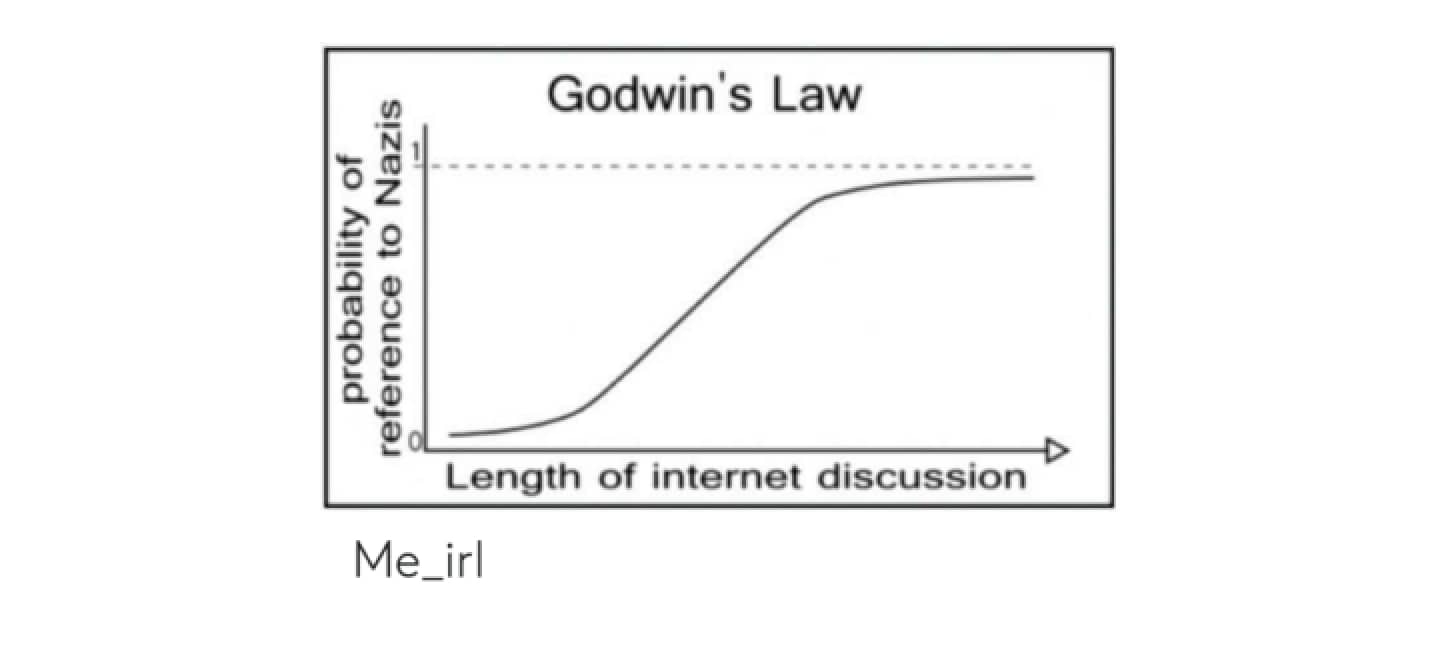Life is a joke.
近年来,梗图(或称“Memes”)变得越来越受欢迎,成为了我们交流的新方式,吸引了很多研究者的注意。本文探讨了梗图中的“语言”,以及它是如何影响数字时代的文化和大家的思维方式。互联网使得更多的社交内容得以传播,这导致文化标签不断变化,也影响到我们如何看待自己的文化身份。这种基于互联网的文化可以看作是由许多小的文化组成的大文化,这些小文化帮助网友们理解和看待世界。在线交流中,我们使用的特定语言也传达了我们的身份,其中梗图就像我们的一张名片。语言学家和其他领域的专家,比如哲学和人类学,都在研究语言和文化之间的联系。—— 本文为转载和摘录,侵删。
1: “OK Boomer.”
Last fall, when 25-year-old Chloe Swarbrick retorted to heckling about her age in a New Zealand parliamentary session on climate change with these two words, the phrase commandeered news headlines. She brought into public discourse the meme that had been seeping across the Internet for the past year, a dismissive cyber eye roll by Generation Z (born 1997–) towards Baby Boomers (born 1946–1965). The polarizing effect of the meme is nothing new; intergenerational clashes always have, and always will, exist. But “OK Boomer” highlights the vitality of memes as a cultural currency. What can memes tell us about Gen Z, the most socially conscious and digitally connected generation?
2: Though Internet memes were first created by millennials (born 1981–1996), the word meme originated with evolutionary biologist Richard Dawkins in 1976, combining the Greek word mimeme—translated to “imitated thing”—and gene. By Dawkins’ definition, memes are cultural ideas that spread and repeat themselves across society. Add the Internet and an evolving sense of humour, and you have the Internet meme: a vessel of communication, a signifier of the comedic zeitgeist, and a device for channelling the inherent anxieties of youth.
3: In a 2018 poll by the Pew Research Center, 70 per cent of American teens reported depression and anxiety as a “major problem”. And it’s easy to see why. Gen Z, arguably more than any other generation, faces an uncertain future: climate change, wage stagnation, political polarization, and mass shootings only scrape the surface. While inequalities in power might play a larger role than age, boomers have come to represent everything wrong with the system for Gen Z. And Internet memes, with their signature eccentricity—for example, the text, “I may look fly, but I want to die” over the image of a person giving a thumbs up—have become the new generations’ method of coping. To the uninitiated, meme humour is nihilistic and outlandish, but the sense of self-awareness translated through memes shares striking similarities to philosopher Albert Camus’ notion of absurdism.
4: In 1942, Camus published the essay The Myth of Sisyphus, which examined the Greek myth of a man destined for eternity to roll a rock up a hill only for it to fall back down each time. The tale encapsulated humanity’s futile existence and the existential torment it permitted; Sisyphus—whom Camus compared to society as a whole—goes through the same continual cycle with no discernable purpose. The very act of living is absurd, Camus found, if there were no meaning to life at all. Yet, he argued, if Sisyphus were to embrace this absurdity, rather than wallow in existential dread or give in to illusory distractions, he could be content, perhaps even happy. This is the same sentiment Gen Z has adopted: embracing the absurdity of the times by making memes about it.
5: In 1990, Godwin’s Law ignited the first viral image—a graph illustrating how the longer an online discussion takes place, the more likely someone will mention Nazis or Hitler. Six years later, John Goodell was tasked with illustrating his company’s 3D character animation software in a movie-to-gif process. He did it with Dancing Baby jamming out to Blue Suede’s classic, Hooked on a Feeling. As Dancing Baby flew through chain emails, Deidre LeCarte—a Canadian arts student—entered a competition with her best friend and sister to see who could gain the most web traffic. Her mono-purpose webpage of dancing rodents received 60,000 hits in four days. A few months later, it reached 17 million. LeCarte created a cult classic, sold an empire worth of merch, and signed her Hamster Dance to a contract with Disney…oh, and she also won the bet.
6: From there, the early 2000s hit. Email and text skyrocketed as primary forms of communication and, as smartphones began to develop, the social media era boomed. It is through these platforms that Grumpy Cat began to brood, the Most Interesting Man found something to say, and Willy Wonka stung us all with his (painfully accurate) sarcastic remarks. The age of memes is here.

7: Memes of today drip with Internet-trademarked black comedy. They’re embellished with a vernacular particular to Internet-moulded youth, making them fascinating and frustrating to older generations. When Gen Z memes remark “oof” or “yikes” to the irreversibility of the Earth’s environmental damage, or express the urge to “yeet into the void” to escape the harsh realities of our times, the blasй responses can be hilarious. But they also contain a blunt and powerful kind of honesty.
8: Perhaps the poignancy of meme humour lies in that Gen Z has no other choice but to embrace the absurdity of the future. Or deal with the environmental consequences of generations before them. But they aren’t carrying this burden with existential dread. They are using the tool they know best—technology—to lighten the weight with a little levity. Memes carry forward a movement defined by both humour and a defiance of past ways of thinking. Because if you can’t laugh in the face of your existential dread, what else can you do?

9: Meme language is multi-sensory
On the surface, internet memes are a ubiquitous source of light entertainment – a way for people to express themselves through cleverly remixed templates of text, images and videos. They are arguably the wallpaper of our social media feeds and often provide us with a few minutes of idle, amusing fodder for procrastination during our day.
10: Firstly, meme culture is far broader than the culture of sharing coded images in replicable templates. A meme itself if a unit of cultural communication and imitation that by its very nature allows us to understand its meaning through a set of shared conventions and codes. Memes exist in all forms of communication, from visual (such as template formats like the “For The Better” meme), to auditory (such as the “Oh No” song by Kreepa used millions of times on TikTok to show moments when things don’t go as expected), to gestural (such as TikTok dances, challenges on Instagram, and other body and video-related content).
11: Crucially, memes can even become part of material products themselves, spawning visual or gestural memes that only serve to continue their embedded jokes. Balenciaga is a prime example of this, notoriously adopting a meme-baiting strategy in their products for the last few years, embedding jokes, parodies, and satire to make their products relevant and infinitely meme-able. This is a model of “media richness,” which offers several different ways for consumers to participate in the joke through either consuming, contributing, or creating in a virtuous cycle with the brand, increasing brand affinity. Indeed, new research published this year suggests that media richness is a more influential factor in consumer engagement and behavioural intention than content trustworthiness. I know, that surprised me too.
I2: In light of this, there is a clear opportunity for brands to take meme culture into account, not only as a form of communicating in a meme-ified market, but to take meme culture into consideration when innovating new products. After all, if Balenciaga can meme-ify Crocs into a desirable shoe, the sky is the limit for all categories.
13: Humour is more important than authenticity:
To that end, the success of integrating multi-sensory meme communication into products relies on the core currency of meme culture: humour. Much has been said about the age of authenticity we’re in, where social media has upended traditional communication hierarchies and brands are expected to be real with their consumers. While, of course, this is true, it’s also incredibly inauthentic to try to be authentic.
14: When it comes to making a meme travel far, humour is the core ingredient. This is because memes themselves function as forms of “energy exchange,” where participating in and putting your own spin on a shared cultural artefact produces an emotional response and increases social bonds. Research in psychology has shown for some time that “hedonic value,” which is value linked to emotional satisfaction, is strongly related to brand loyalty, brand affinity, and positive electronic word-of-mouth.
15: Humour in a meme context often relies on being in-on-the-joke, meaning that to be authentically funny, brands need to be participants in the communities they’re advertising to. Wendy’s TikTok presence is a great example of participating in fast-moving meme humour without being too heavy or inauthentic, often relying on remixed existing meme formats that make them feel like an authentic participant in the humour of meme culture, much like a regular users. Younger consumers are particularly wise to marketing strategies, so embedding humour and participation is crucial to leveraging memes to build brand affinity.
16: Collaboration creates content richness
As our time online increases, so does our exposure to marketing and advertising. In my research over the years, I’ve been so surprised by how savvy even the youngest consumers are about the influence of advertising on their communication and behaviour, and how critical they are of brands that are doing it wrong on social media. Often, it’s when brands participate in a trend that they didn’t start that they really win over the hearts of users, contributing to the sense of “media richness” that makes a brand’s contribution to their feed actually meaningful. Sure, traditional influencer marketing has its place, but digital creator collaboration (like Gucci’s latest foray into gaming culture on Twitch with 100 Thieves) is beginning to usher in a new form of brand activation that relies less on traditional modes of engagement. This new form of creator collaboration in meme cultures creates real digital content richness around marketing efforts, making brands on social media far less cringe-y to media literate youth who want brands to communicate on their level.
17: A core function of participating in meme culture in this meaningful way is recognising that meme culture itself upends traditional brand and consumer hierarchies, placing consumers in a co-creation role with brands. The meme that inspired me to buy those limited edition Crocs wasn’t from the Crocs account itself, but from a regular user repurposing the brand image to make a joke. It wasn’t even a complimentary joke! Brands are artefacts in meme culture whether they participate in it directly or not, so it makes sense to take hold of this incredible opportunity that brands now have to humanise, connect, and play a more relevant role in the platforms we’ll continue to be glued to for some years to come.
18: Meme Culture & Mental Health: Does It Help?
It may surprise you to know that the word “meme” is far from a recent phenomenon. Nor is it the birth child of millennials and influencers. It was actually coined in 1976 by a controversial evolutionary biologist in his book, The Selfish Gene. Richard Dawkins used the term “meme” in parallel meaning to our biological genes - transmitters of information and masters of imitation. Unlike genes however, memes are transmitters of cultural value.
19: You and I likely now have a much narrower and popularised perception of memes in that they are an image, video or piece of text that spreads rapidly and widely online. There will be millions of memes flying around the internet at any one time, ever-evolving so that they stay on trend. You’d be hard pressed to spend any time on social media without seeing a meme or two and there are plenty of dedicated instagram accounts boasting a following of six-figures or more.
20: This is also true for the more recent explosion of mental health memes. But why have they become so popular? Memes are a funny, witty and sometimes outright nonsensical means of highlighting a titbit of our human experience. They are a classic case of shared observational humour, taking an everyday phenomenon and drawing our attention to it in the cold light of day in a way that says “hey, did you notice this thing - isn’t it weird”. The phrase “it’s funny because it’s true” springs to mind.
21: But to reduce memes to simply ‘comedy content’ would be unfair. Mental Health memes have a valuable role in starting conversations. In the age of digital we are, more and more, using the sending of images to communicate with one another. I would hazard a guess that, on average, I send a #relatable meme directly to another person at least once a day. At least. Usually more. And most of the time I don’t need to say anything else, but it’s all there, in that image. I am also partial to an Instagram story re-share if they are particularly good, which kills anywhere between two-hundred to 300 birds with one conversation-starting stone, so to speak.
22: A meme can also help us to express thoughts and feelings we aren’t able to articulate in our own voice. Whether it’s because we’re not ‘out’ as someone who is comfortable speaking openly about their mental health, or because we simply do not understand how to put our past or present experiences into words, memes are a tool for communicating. The stigma and shame which exists around the mental health conversation is still acutely felt by many. To engage with content that discusses mental health but is created by somebody else is to protect oneself from the stigma. Where mental health stigma is the monster under the bed, memes are the safety blanket.
23: Of course it makes sense that the memes we find most hilarious are the ones we find most relatable. There is something strangely comforting about having someone hold a mirror up to your deepest, darkest, mental health struggle and reflect it back to you as a 240-character tongue-in-cheek witticism that’s gone viral. To know that even one other person out there in the big wide world is thinking or feeling the same way as we are is an extremely powerful thing. Not feeling alone, particularly in the mental health arena, can be a game changer. In that sense, I can’t fault the internet for its ability to connect people through shared experiences and Gene Wilder memes.
24: We are perhaps in a better place societally with regards to mental health awareness having a seat at the table, for example in 2020 the UK government launched the Every Mind Matters campaign and in 2021 went on to appoint Dr. Alex George as Ambassador as Youth Mental Health. And whilst we are yet to see the real-world impact of these implementations, I’m willing to chalk these up as small steps in the right direction.
25: But this reliance on getting laughs from self-deprecating humour is arguably not achieving the most favourable outcome. If what we’re looking for is more meaningful conversations around mental health and mental illness, conversations free from stigma, embarrassment or shame, we may not yet be striking quite the right balance between meme culture being an encouragement and a deterrent. Whilst humour can bring lightness to the topic, it also runs the risk of gatekeeping the serious conversations.
26: For someone at the very beginning of their journey of exploring their mental health, we run the risk that their earliest conversation and experiences teach you that humour is a prerequisite to the mental health conversation. As a result, you may not learn how, or may be less inclined, to initiate more sincere conversations when needed, with friends, family or health professionals. This is a particular worry for younger generations who are arguably much more likely to be first exposed to the mental health conversation online than with those close to them in the real world. But there’s more. With little room for nuance or depth, are we sure that the version of mental health, wellbeing and illnesses portrayed in memes and other online media is true, objective, accurate or even helpful?
27: I have been talking about mental health online for a few years now and memes are still a well used resource in my arsenal for normalising the topic of mental health. Mental health and mental illness is no laughing matter but I do think memes have a place in challenging stigma and bringing mental health into the public consciousness. Only time will tell if Dawkin’s theory is correct and the rise in memes will shape our perception of mental health in generations to come for the better. For now, let memes be the appetiser and enjoy them, but we shouldn’t forget to also hold space for the heavier stuff that’s cooking too.

28 The behavioural science of memes
There are at least three cognitive biases that make memes such an effective and popular mode of communication…
1. THE IKEA EFFECT:
Co-creation is the lynchpin of meme culture. Memes are designed to be replicated, re-contextualised and remixed according to the whims and creativity of other internet users.
29: In addition to being fun, this participatory nature of memes taps into one of my favourite cognitive biases: the IKEA effect. The IKEA effect is the behavioural bias that describes how we become over-invested in things that we helped to create. The name comes from a suite of studies in the last decade that show that we are willing pay extra money to avoid having to part with our lovingly self-assembled furniture, even if it will be replaced with an identical, factory-made replica. So, when meme culture invites us to join in as participants and creators, it harnesses the power of the IKEA effect: our very participation leads us to love memes all the more.
30: 2. COGNITIVE LOAD
One of the more fundamental facts of human psychology is that we can only handle so much information at once, a fact that behavioural scientists like to call the principle of cognitive load. The principle of cognitive load warns us that brain energy is a finite resource, which quickly depletes when we are asked to concentrate on a difficult task. To conserve this precious mental resource, we are biased to avoid complexity and seek simplicity wherever we can – even if that comes at the cost of accuracy, integrity or our long-term interests.
31: In light of this need for simplicity, the appeal of memes comes into focus. Memes excel in packaging complicated socio-political commentary and satirical discourse into concise, digestible chunks. Rather than falling into the trap of trying to communicate too many things at once, memes pack their focussed punch by honing in on one singular idea.
32: Not only that, but memes also benefit from the power of repetition – we see subtle variations of the same meme again and again until their format is burned into our memories. Simplicity, singularity, and consistency are the antidotes to cognitive load. Memes, then, are a good reminder that less is more in the art of effective communication.
33: 3. BEHAVIOURAL CONTAGION:
Another notable feature of memes is their capacity to go ‘viral’. Part of what supports this virality is the psychological mechanisms of behavioural contagion. And don’t worry, this kind of contagion doesn’t have anything to do with actual viruses – it refers instead to our tendency to mimic the behaviours of those around us.
34: For example, after you spot a colleague yawning at their desk on a Monday morning, you may catch yourself yawning moments later. And before you know it, the whole office is at it! That’s behavioural contagion in action. The contagious nature of laughter is another nice example – the laughing track of a sit-com can transform even the most mediocre of jokes into side-splitters.
35: The human tendency toward mimicry is fuel to the fire of meme culture, burning its way across the internet via retweets, cross-posts and imitation. As such, the major metric of the success of a meme is how many times you’ve seen imitated online. Given this, it is no coincidence that memes have found a fertile home in social media environments where social cohesion and immediate feedback are in-built features. Part of the appeal of the meme, then, is its ability to tap into our social instincts and desire to ‘fit in’ with the crowd.
36 What does it all meme?
Using the tools of behavioural science to examine memes has taught us three lessons in the art of human communication that can apply to every type of communication:
- Keep your messages simple, and favour repetition over reinvention
- Invite participation and co-creation to help your audience to invest themselves in your product and help your messages land
- Mimic the language of your audience, and highlight the popularity of the ideas you’re communicating to give them extra power.
With these principles in mind, we asked the creative minds at HRW to create some original market research memes. See how many of these communication principles you can spot in the memes!

